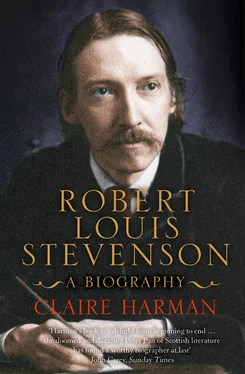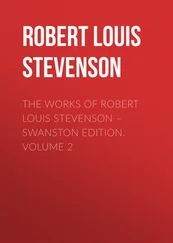ROBERT LOUIS STEVENSON
A Biography
CLAIRE HARMAN
Dedication DEDICATION PREFACE 1 Baron Broadnose 2 Velvet Coat 3 The Careless Infidel 4 Ah Welless 5 Stennis Frère 6 The Amateur Emigrant 7 The Professional Sickist 8 Uxorious Billy 9 A Weevil in a Biscuit 10 The Dreamer 11 Below Zero 12 Ona 13 Tusi Tala 14 The Tame Celebrity Postscripts SELECT BIBLIOGRAPHY INDEX ACKNOWLEDGEMENTS ABOUT THE AUTHOR NOTES PRAISE BY THE SAME AUTHOR COPYRIGHT ABOUT THE PUBLISHER
To
Paul Strohm,
dear companion
COVER
TITLE PAGE ROBERT LOUIS STEVENSON A Biography CLAIRE HARMAN
DEDICATION Dedication DEDICATION PREFACE 1 Baron Broadnose 2 Velvet Coat 3 The Careless Infidel 4 Ah Welless 5 Stennis Frère 6 The Amateur Emigrant 7 The Professional Sickist 8 Uxorious Billy 9 A Weevil in a Biscuit 10 The Dreamer 11 Below Zero 12 Ona 13 Tusi Tala 14 The Tame Celebrity Postscripts SELECT BIBLIOGRAPHY INDEX ACKNOWLEDGEMENTS ABOUT THE AUTHOR NOTES PRAISE BY THE SAME AUTHOR COPYRIGHT ABOUT THE PUBLISHER To Paul Strohm, dear companion
PREFACE
1 Baron Broadnose
2 Velvet Coat
3 The Careless Infidel
4 Ah Welless
5 Stennis Frère
6 The Amateur Emigrant
7 The Professional Sickist
8 Uxorious Billy
9 A Weevil in a Biscuit
10 The Dreamer
11 Below Zero
12 Ona
13 Tusi Tala
14 The Tame Celebrity
Postscripts
SELECT BIBLIOGRAPHY
INDEX
ACKNOWLEDGEMENTS
ABOUT THE AUTHOR
NOTES
PRAISE
BY THE SAME AUTHOR
COPYRIGHT
ABOUT THE PUBLISHER
Robert Louis Stevenson has always been a popular author but never a canonical one. The Strange Case of Dr Jekyll and Mr Hyde, Treasure Island, Kidnapped, A Child’s Garden of Verses – four very different popular classics – have not appeared on syllabuses of nineteenth-century literature until very recently. The critical consensus up to the last twenty years or so seems to have been that Stevenson’s works were not quite ‘literary’ enough to study.
This has been an odd fate for a man who was thought to be, by his contemporaries in the 1870s, the star of his generation, an English stylist of giddying promise, an Elia for the fin-de-siècle. In his hands, the personal essay seemed to be coming to perfection in an arresting combination of high polish and novel directness, while aphorisms poured from his young mouth straight into the dictionaries of quotations. His influential friends in the world of letters, William Ernest Henley, Sidney Colvin, Leslie Stephen, Henry James and Edmund Gosse, all waited eagerly for the masterpiece. Would he excel as an essayist? a playwright? a poet? a historical novelist to equal Sir Walter Scott? His rivals watched him carefully too, none more so than Thomas Hardy, Stevenson’s fellow heir-in-waiting to George Meredith in the 1880s, and Joseph Conrad, keen to distance himself, after Stevenson’s death, from a writer he feared had influenced him too much.
Stevenson’s impatience with his friends was clear when, after the publication of Dr Jekyll and Mr Hyde , they began to lament his decline into mass popularity. Making money was of more immediate importance to the invalid author than the production of ‘damned masterpieces’, however much he would have liked to fuse the two if possible. Though he looked like a dilettante, a flimsy ‘Ariel’ (as Henley and Colvin both described him), Stevenson was a highly professional writer and produced hundreds of works: essays, poems and articles, melodramas, polemical pamphlets and some thirty full-length books, among which were works as diverse as New Arabian Nights, The Ebb-Tide, Prince Otto and In the South Seas. None of these is read much any more, but then neither are his most celebrated books: Dr Jekyll and Mr Hyde and Treasure Island are so well-known that they hardly require to be read at all. We all understand what ‘Jekyll-and-Hyde’ signifies, and Long John Silver is more real to most people than any historical buccaneer. So in some senses, Stevenson’s neglect has come at him from more than one direction.
We think of writers’ careers in terms of what they publish; they think of what they have written, or intended to write. For a variety of reasons, Stevenson made a great many beginnings and relatively few ends. The extent of his unfinished works only began to be clear with the publication of Roger Swearingen’s Guide to the Prose Writings of Robert Louis Stevenson in 1980, and was dramatically confirmed by the wealth of new evidence presented in the eight-volume Yale edition of The Letters of Robert Louis Stevenson , published in 1994–95, the most substantial and revealing addition to the Stevenson canon since the author’s death. Stevenson emerged from the new Letters not just as an outstanding practitioner of the form but as a man of penetrating intelligence and strong feelings, with a wide range of interests, a volatile attention span, powerful ambition to succeed and a constant, pressing desire to earn money. He appeared more quirkily humorous than before, but also more vulnerable, for this most eloquent of writers turns out to have been a slave to writer’s block, strangely fixated on his second-rate works and casual about his best ones, always anxious that his chosen profession was neither very admirable (unlike his engineer family’s) nor very sustainable.
The sense of urgency about establishing himself as a writer that Stevenson felt and his friends shared was sharpened by their concept of him as doomed to die young. From infancy, Stevenson’s health had been poor, his physique underdeveloped, his ailments (watched over with undue care by hypochondriac parents) legion. No wonder he became convinced of his own short lease on life, and perturbed at the thought of ‘outliving’ it into maturity, even old age. The effects on his writing were transparent: if difficulties presented themselves, he was tempted – felt almost licensed – to bail out. Hence his biography of Hazlitt, his history of the Act of Union, biography of Viscount Dundee and novel about the Peninsular War are just four of dozens of unfinished magna opera , and many of his published works blazon their own incompleteness and uncertainty with a brilliant insouciance. And while he liked to think he could have achieved much more in good health, the truth is probably the reverse. Just as Coleridge’s person from Porlock relieved the poet from the drudgery of having to finish ‘Kubla Khan’, chronic illness provided Stevenson with a constantly available excuse not to polish or even complete many of his works, leaving him free to do what he enjoyed most, which was to start something new.
What illness, or combination of illnesses, he suffered from becomes less clear as we discover more about Stevenson’s life. He was brought up in the fear and expectation of developing tuberculosis, and his chest ailments all pointed to that diagnosis, although on the occasions when tests were carried out (and Stevenson had access to the very best medical attention money could buy) they never proved positive. The blood-spitting that began when he was thirty certainly indicated consumption, but he might also have been suffering from hypertension, cardiac disease, syphilis, or a combination of all of those. The cause of his death, aged forty-four, was recorded as a cerebral haemorrhage.
The fact that some things become less knowable about a subject the more data accrues around them is of utmost importance to any biographer. Order – the existing order, the existing story – will break down to some extent and the edges of the familiar portrait blur. This is the point at which it becomes possible to see glimpses of the messiness and complexity of real life poking through. Stevenson provides a willing accomplice to this process: he was unusually greedy of experience and open to the widest possible interpretation of personality. Duality, the theme of his most famous work, is present in almost all his writing:
Читать дальше












